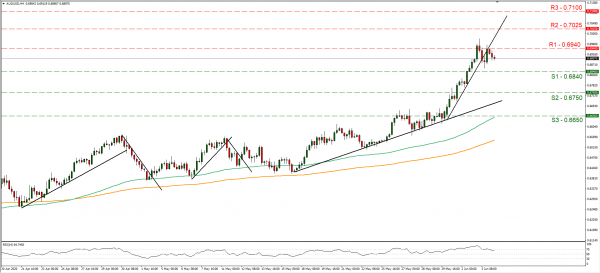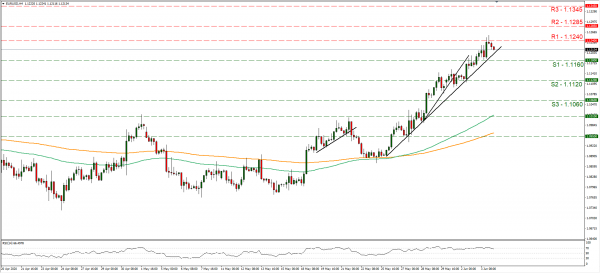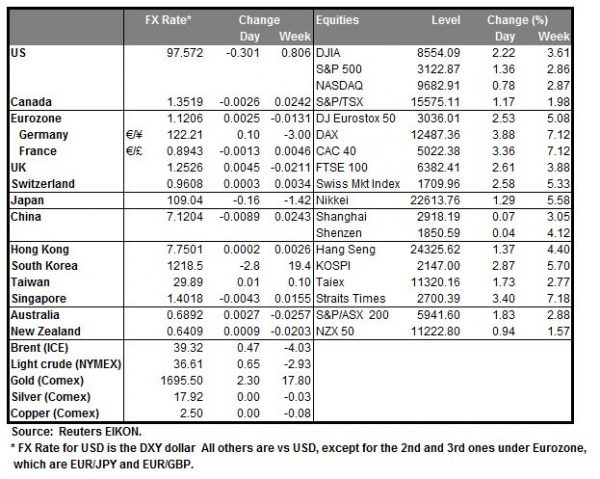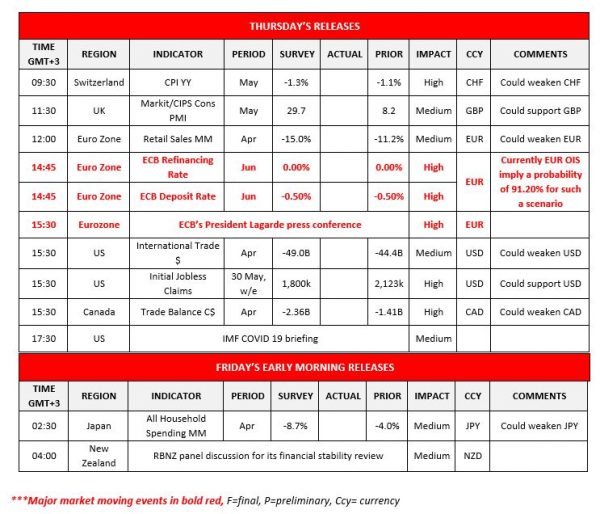AUD weakened against the USD as traders may have chosen to book some profits after the pair reached a 5-month high. It should be mentioned though that analysts tend to revise upwards the outlook for the currency, given that Australia had a relatively low number of coronavirus cases, implying that a rebound may be quicker than elsewhere. At the same time, it should be noted that Australia’s retail sales growth rate for April reached a record low contracting by -17.7% month on month, which underscored the damage done by the lockdown measures imposed. On the flip side the USD seems to start stabilizing temporarily, despite unrest still being present in the US and creating turmoil. Should the positive market sentiment persist and a risk on attitude retake the markets, we could see the Aussie starting to rise once again. AUD/USD found resistance at the 0.6940 (R1) level, proving unable to break it. As the pair broke the upward trendline incepted since the 15th of May, we switch our bullish outlook in favor of a sideways movement. Please note that the RSI indicator below our 4-hour chart remains is till near the reading of 70, underscoring the presence of the bulls. Should the pair find fresh buying orders along its path, we could see it breaking the 0.6940 (R1) line and aim, if not break the 0.7025 (R2) level. Should the pair come under the selling interest of the market, we could see it breaking the 0.6840 (S1) line and aim for the 0.6750 (S2) level.
ECB’s interest rate decision awaited by EUR traders
Today in the late European session (11:45, GMT) ECB is to release its interest rate decision and is widely expected to keep rates unchanged with the refinancing rate being at 0.0% while the deposit rate at -0.50%. Currently EUR OIS imply a probability of 91.20% for the bank to remain on hold and actually keeping them at those levels throughout the year. Hence market attention is expected to turn to the accompanying statement and Lagarde’s press conference (12:30, GMT) later on, as well as the updates of the economic projections. According to ECB President Lagarde’s statements a contraction of 8-12% for the area’s GDP for 2020 is expected, while we would not be surprised to see the inflation forecasts be gloomy as well, both with a rebound in 2021 and 2022. In the GDP area any rate nearing -8% could support EUR, while anything near -12% could weaken it. Also, the bank is expected to expand its PEPP program and some analysts even mention an upscale of around €500 billion. The bank is to cheer the €750 billion stimulus of the EU as well as the recent additional stimulus of the German government of €130 billion. Overall, we expect the event to be interesting, yet with little if any surprises and if so, it could provide some support for the EUR. EUR/USD continued to rise yesterday testing the 1.1240 (R1) resistance line yet failing to break it and retreated a bit lower. We maintain a bullish outlook for the pair as long as it remains above the upward trendline incepted since the 26th of May, however, please note that the pair seems about to test it once again. If the bulls maintain control, EUR/USD could break the 1.1240 (R1) resistance line and aim for the 1.1285 (R2) resistance level. If the bears prevail, the pair could break the prementioned upward trendline, the 1.1160 (S1) support line and aim for the 1.1120 (S2) level.
Other economic highlights today and early tomorrow
Today during the European session, we get the Swiss CPI rate for May, UK’s construction PMI for May and Eurozone’s retail sales growth rate for April. In the American session, we get the US international trade balance for April, yet traders may focus on the release of the initial jobless claims figure. Also, in the American session, from Canada we get the trade balance for April. In the Asian session, we get Japan’s household spending growth rate for April. Also please note that today IMF holds a regular briefing to discuss global economy and the impact of the COVID-19 pandemic so there may be some turbulence there affecting the market sentiment for a recovery of the global economy.
Support: 0.6840 (S1), 0.6750 (S2), 0.6650 (S3)
Resistance: 0.6940 (R1), 0.7025 (R2), 0.7100 (R3)
Support: 1.1160 (S1), 1.1120 (S2), 1.1060 (S3)
Resistance: 1.1240 (R1), 1.1285 (R2), 1.1345 (R3)


















